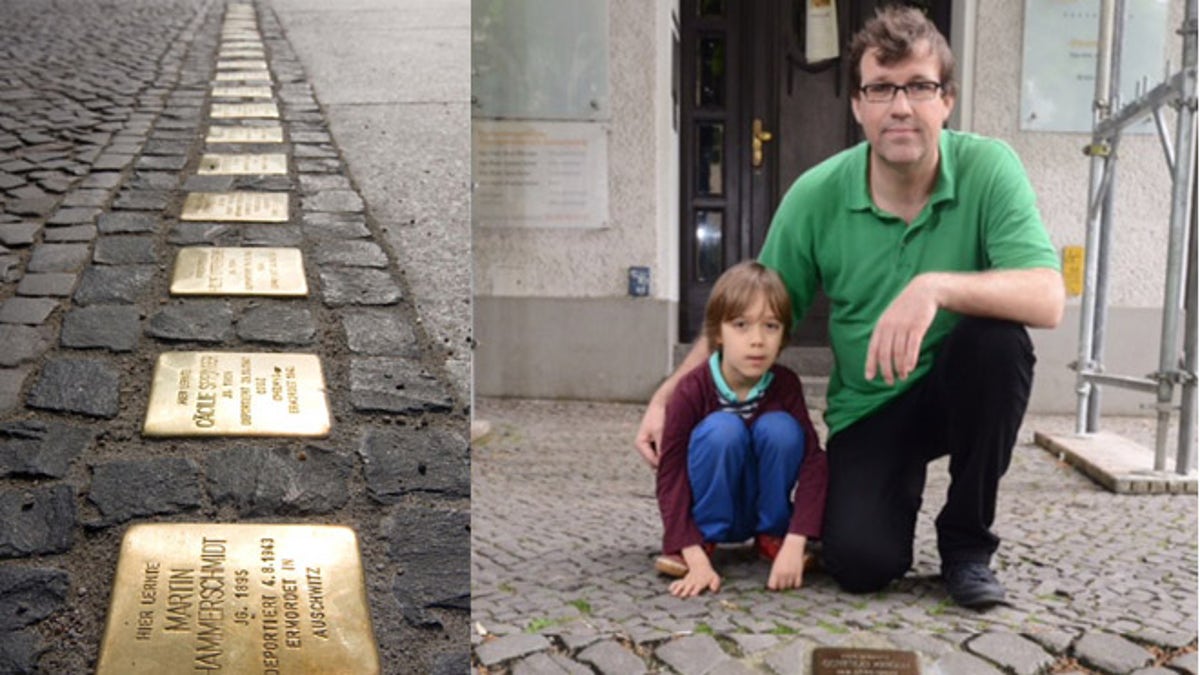
Markus Hesselmann and his son, Juri, view one of the plaques that commemorate victims of the Holocaust. (Mike Wollf/Tagesspiegel)
Reminders of Germany’s dark past confront 7-year-old Juri Hesselmann each morning as he walks to school with his father.
The Stolpersteine, or “Stumbling Stone” memorials – handmade plaques that memorialize the Jews who once lived in Juri’s neighborhood – are found in front of every other house on the tree-lined Guntzelstrasse, a main street in what was a heavily Jewish area of Berlin before World War II.
Many Jewish intellectuals, including Albert Einstein, lived in this neighborhood.
Embedded in the sidewalk, flush with the ground, these cobble-stone sized brass plaques identify the Jewish residents who lived in each of these homes before being murdered in the Holocaust.
A typical Stolperstein reads:
Here lived Gertrud Kirsch
Born Lowenberg 1895
Deported August 15, 1942
Riga, Latvia
Murdered August 18, 1942
Most Jews deported to Riga were marched several miles to a forest and killed.
The word “ermordet” – “murdered” – is almost always on the plaques. Or sometimes the plaque says “flucht in den tod” – “killed while trying to escape.”
Juri’s father, Markus Hesselman, an editor at Der Tagesspiegel, Berlin’s largest newspaper, wrote about Gertrud Kirsch in his paper.
In 1939, Kirsch, a 46-year-old widow, sent her 18-year-old daughter, Helga, to safety in London. Repeated efforts to join Helga in England, however, failed. In her correspondence with Helga, Kirsch sought to reassure her daughter that she was well in spite of the tightening Nazi noose.
In May 1941, in what appears to be her last letter, Kirsch congratulates Helga on her engagement. “I hope we can celebrate the engagement together,” she wrote.
A year later she was dead.
The first Stolpersteine in Berlin were placed in 1996. Memorializing 50 Jewish residents of Berlin’s Kreuzberg district, they were the creation of German artist Gunter Demnig as part of an art project that examined Auschwitz, the German death camp in Nazi occupied Poland, where 1.1 million people were gassed, shot, beaten, or died from disease and hunger.
These first Stolpersteine were considered illegal. But the Berlin authorities later relented.
In the 20 years since, Demnig has placed nearly 60,000 Stolpersteine throughout Europe, from Norway to Greece, with more than 7,000 in Berlin alone. Astonished by the demand for these memorials, Demnig has acknowledged that the job has consumed his life.
Demnig now has an assistant, Michael Friedrichs-Friedlander, who was especially moved by the 34 plaques he made for orphans and their caregivers. These plaques were placed in front of an orphanage in Hamburg.
“They were between three and five years old,” Friedrichs-Friedlander told the German government broadcaster Deutsche Welle. “I couldn’t sleep for weeks.”
The plaques serve as constant reminders to the residents of neighborhoods like Juri’s that the Nazi death machine took so many Jews from the neighborhood. They force residents to think. How would they react if they had a Jewish neighbor who vanished in the night? What would you do if your neighbor were taken away today?
“Standing in front of the houses where the victims lived, loved, ate, and slept gave me the shivers,” said Brita Wagener, Germany’s consul general in New York, describing her reaction to the first Stolpersteine she saw. “A few years ago Stolpersteine were placed in front of my high school to remember the Jewish students.”
According to Helmut Lolhoffel, a spokesman for the Charlottenburg-Wilmersdorf Stolpersteine project, there were 13,200 Jewish residents deported from this area of Berlin and murdered by the Nazis. The Charlottenburg-Wilmersdorf area includes Juri’s neighborhood. Altogether there were 55,000 Jews deported from Berlin and killed.
Lolhoffel, 72, whose parents were Nazis, said that Germans must forever commemorate the victims of the Nazis.
“The Stolpersteine are our permanent reminders,” said Hesselmann, noting that their importance grows as the number of survivors who can tell the story of the Holocaust shrinks.
Hesselmann and Juri regularly clean one of the Stolpersteine in front of a local kindergarten. And flowers are placed on the Stolpersteine every year on Nov. 9, the anniversary of Kristallnacht when, in 1938, the Nazis torched synagogues, vandalized Jewish homes and killed 100 Jews.
